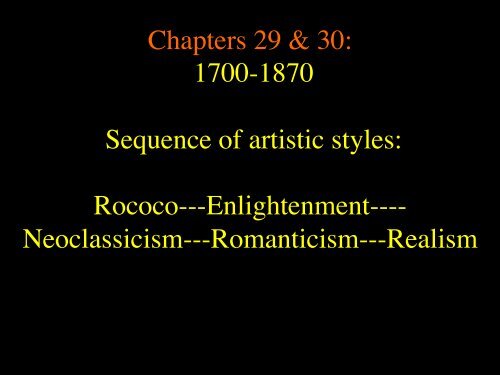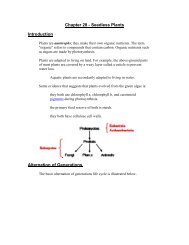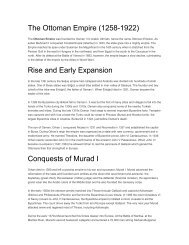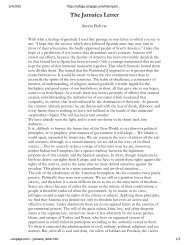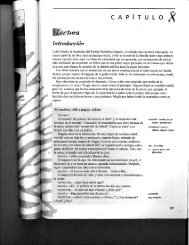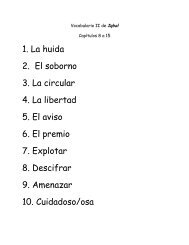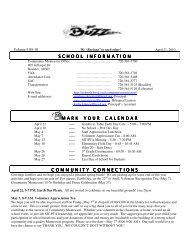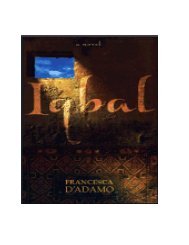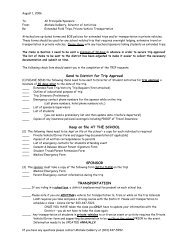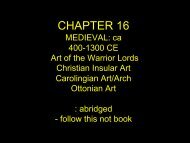Ch 29-30 2013 - Bvsd
Ch 29-30 2013 - Bvsd
Ch 29-30 2013 - Bvsd
Create successful ePaper yourself
Turn your PDF publications into a flip-book with our unique Google optimized e-Paper software.
<strong>Ch</strong>apters <strong>29</strong> & <strong>30</strong>:<br />
1700-1870<br />
Sequence of artistic styles:<br />
Rococo---Enlightenment----<br />
Neoclassicism---Romanticism---Realism
<strong>Ch</strong>. <strong>29</strong> -<strong>30</strong>:<br />
Birth of the “Isms”<br />
• Patchwork of several artistic trends, each<br />
reacting to the previous<br />
• Enormous variety from 1700 – 1800- rapid<br />
shifts in style and subject matter<br />
• No 1 single style dominated, such as in<br />
Renaissance and Baroque<br />
• Rococo = short-lived<br />
• Neoclassicism, Romanticism and Realism<br />
= overlap & blend & compete with each<br />
other.
ENGLISH NEOCLASSICAL<br />
<strong>Ch</strong> <strong>29</strong>-<strong>30</strong> Important ideas for NEOCLASSICAL / ROMANTIC<br />
ROCOCO: Primarily a form of decorative interior decoration: curvilinear, delicate ornamentation favored by the French<br />
aristocracy who lived a frivolous existence devoted to pleasure. Its short duration ended in 1760. Mood: playful,<br />
superficial, energetic. Colors: white, silver, gold. Shapes: sinuous, arabesques, S and C curves.<br />
THE ENLIGHTENMENT<br />
The majority of the art and architecture discussed in this chapter was influenced by Enlightenment philosophy, a major current in<br />
Western thought. Neoclassical art in particular showed the influence of the Enlightenment in its choice of subject matter—for<br />
example, David's OATH OF THE HORATII or DEATH OF SOCRATES. Later works, such as Goya's THIRD OF MAY, 1808 should<br />
be seen as a reaction to the Enlightenment.<br />
NEOCLASSICISM VERSUS ROMANTICISM<br />
One theme of these chapters is the contrast between Neoclassicism and Romanticism. By the end of the chapters, students<br />
should be able to analyze the differences between these two styles in terms of composition, choice of subject matter, proportion,<br />
color, and so on. Understanding the distinction between these two styles is especially important in French painting, where the<br />
inheritors of these artistic traditions will become the earliest modernists.<br />
INFLUENCE OF NAPOLEON<br />
Students should be aware of the influence of Napoleon on French art by being able to identify which artists worked for Napoleon,<br />
which were sympathetic to his regime, and which were opposed to it. They should consider David, Ingres, Delacroix, and Goya. A<br />
central question for students to discuss is how important a role Napoleon's patronage played in the art of this period.<br />
THE AMERICAN IDENTITY<br />
Artists in the new United States of America tried to capture the spirit of their fledgling republic in their art, but comparing the art of<br />
the young nation with that of its European antecedents reveals strong influences, as well as new unique forms such as naturalistic<br />
painting.
Rococo:<br />
1700s<br />
“ the pursuit of happiness & love”<br />
Roots<br />
C/C to Baroque<br />
Stylistic characteristics
Hotel: French town houses<br />
of the elite epitomized<br />
Rococo.<br />
ROCOCO Germain Boffrand, Salon de la Princesse , Paris, France ca<br />
1737-1740<br />
This is a typical French<br />
Rococo Room.<br />
The room is comprised of<br />
sinuous curves luxuriantly<br />
multiplied in mirror<br />
reflections.<br />
Painting, architecture, and<br />
sculpture combine to form a<br />
single ensemble.<br />
tendrils: A twisting,<br />
threadlike structure by<br />
which a twining plant, such<br />
as a grape or cucumber,<br />
grasps an object or a plant<br />
for support.
François de Cuvilles, Hall<br />
ROCOCO<br />
of Mirrors, Munich,<br />
Germany, early 1700s.<br />
Delicate, Organic, Ornate, Detailed, Reflective, Fanciful, Festive
ROCOCO
ROCOCO<br />
Catherine Palace, Russia, cue card
Portrait of Louis XIV, 1701<br />
BAROQUE.<br />
ROCOCO Antoine Watteau, L’Indefferent, 1716.<br />
ROCOCO
This painting represents a<br />
group of lovers preparing<br />
to depart from the island<br />
of eternal youth and love,<br />
sacred to Aphrodite.<br />
Young and luxuriously<br />
costumed, they perform,<br />
as it were, an elegant,<br />
tender, and graceful<br />
ballet, moving from the<br />
protective shade of a<br />
woodland park, peopled<br />
with amorous cupids and<br />
voluptuous statuary, down<br />
a grassy slope to an<br />
awaiting golden barge.<br />
ROCOCO Antoine Watteau, Return from Cythera, 1717-1719<br />
Fete Galante = ‘elegant outdoor entertainment’
• The beauty of a<br />
material object could<br />
be recreated by use of<br />
a line to create form.<br />
• Color was seen as<br />
transitory &<br />
decorative. The<br />
Renaissance masters<br />
were the models of<br />
“disegno”.<br />
Line vs Color<br />
• Color satisfies the<br />
eye; line satisfies the<br />
mind.<br />
• Texture<br />
• Layers<br />
• Emotion
ROCOCO
ROCOCO
ROCOCO Antoine Watteau, Pilgrimage to Cythera, 1717.
ROCOCO Francois Boucher, Cupid a Captive, 1754<br />
Boucher was a follower of Watteau and the<br />
painter for Madame de Pompadour ( the<br />
influencial mistress of Louis XV)<br />
His fame was gained through his paintings of<br />
graceful allegories, with Archadian shepherds,<br />
nymphs, and goddesses cavorting in shady<br />
glens engulfed in pink and sky blue light.<br />
“Boucher’s paintings are highly caloric with little<br />
nutritional value”
ROCOCO<br />
Francois Boucher, Marquise de<br />
Pompadour , 1756.
Fragonard was a student of Boucher<br />
and is considered by many to have<br />
surpassed the genius of his master.<br />
This is a typical “intrigue” picture. A<br />
young gentleman has managed an<br />
arrangement whereby an unsuspecting<br />
old bishop swings the young man’s<br />
pretty sweetheart higher and higher,<br />
while her lover (and the work’s<br />
patron), in the lower left-hand corner,<br />
stretches out to admire her ardently<br />
from a strategic position on the<br />
ground.<br />
The young lady flirtatiously and boldly<br />
kicks off her shoe at the little statue on<br />
the god of discretion, who holds his<br />
finger to his lips.<br />
ROCOCO Jean-Honré Fragonard, The Swing, 1766
ROCOCO Jean-Honoré Fragonard, The Bathers, 1766.
Art of the Enlightenment<br />
ROCOCO<br />
Includes both paintings that depict<br />
topics of the Enlightenment as well as<br />
those that demonstrate a new style<br />
and iconography called “Natural” art<br />
and Grand Manner portraiture.<br />
Rationalism<br />
Empiricism: scientific method
ENGLISH NEOCLASSICAL<br />
Joseph Wright of Derby, A Philosopher Giving a Lecture at the Orrery , 1763-1765.<br />
Role of light: new<br />
meaning
ENGLISH NEOCLASSICAL<br />
An Experiment on a Bird in the Air<br />
Pump is a 1768, Joseph Wright of<br />
Derby, 1786 oil on canvas
ENGLISH NEOCLASSICAL<br />
Coalbrookdale Bridge, 1776
ENGLISH NEOCLASSICAL<br />
Crystal Palace, London, 1851
ENGLISH NEOCLASSICAL Eiffel Tower, Paris,<br />
1889
FRENCH NEOCLASSICAL<br />
Natural Art<br />
Vigee-Le Brun, Self-<br />
Portrait, 1790<br />
Cue card<br />
Natural Art: based on Jean<br />
Jacque Rousseau’s views<br />
on man and his natural<br />
state:<br />
“To exist is to feel…nature<br />
must be the guide..”<br />
Thus, move away from<br />
Rococo & embrace a more<br />
natural style.<br />
Here: she has paused & is<br />
looking directly at viewer.<br />
Female, self-confident.
Natural Art<br />
FRENCH NEOCLASSICAL<br />
Élisabeth Louise Vigée-Le Brun<br />
Marie Antoinette at age 12,<br />
1790<br />
.<br />
On 7 August 1775 she married Jean-Baptiste-<br />
Pierre Le Brun, a painter and art dealer. Her<br />
husband's great-great-uncle was <strong>Ch</strong>arles Le<br />
Brun, first Director of the French Academy<br />
under Louis XIV.<br />
Yes, spelled Le Brun<br />
I apologize!!!
ENGLISH NEOCLASSICAL<br />
William Hogarth, Self-Portrait with Pug-Dog. 1745.<br />
William Hogarth (1697 –1764) was a<br />
major English painter, printmaker,<br />
pictorial satirist, social critic and<br />
editorial cartoonist who has been<br />
credited with pioneering western<br />
sequential art. His work ranged from<br />
excellent realistic portraiture to comic<br />
strip-like series of pictures called<br />
“modern moral subjects”. Much of his<br />
work, though at times vicious, poked<br />
fun at contemporary politics and<br />
customs. Illustrations in such style are<br />
often referred to as Hogarthian.
ENGLISH NEOCLASSICAL William Hogarth, The Marriage Contract from Marriage a la Mode, 1743.<br />
Democratization of culture &<br />
knowledge<br />
Role of printing presses to<br />
mass produce works of art
ENGLISH NEOCLASSICAL
ENGLISH NEOCLASSICAL William Hogarth, Breakfast Scene from Marriage a la Mode, 1745.<br />
Steen, St. Nicholas<br />
Feast, 1665
Grand Manner portraiture: homage to<br />
Rome/gravitas<br />
ENGLISH NEOCLASSICAL<br />
Sir Joshua Reynolds:<br />
aristocratic<br />
interpretation of<br />
“naturalness”—great<br />
people with natural<br />
traits of heroism &<br />
character.<br />
Sir Joshua Reynolds was the<br />
most important and influential of<br />
18th century English painters,<br />
specializing in portraits and<br />
promoting the "Grand Style" in<br />
painting which depended on<br />
idealization of the imperfect.<br />
Sir Joshua Reynolds<br />
Sir Joshua Reynolds<br />
Miss Elizabeth Ingram. 1757.
Grand Manner portraiture: homage<br />
to Rome/gravitas<br />
ENGLISH NEOCLASSICAL<br />
Sir Joshua Reynolds<br />
Portrait Of Richard Peers Symons<br />
1770.<br />
Sir Joshua Reynolds
ENGLISH NEOCLASSICAL Sir Joshua Reynolds
Nature & portraiture<br />
ENGLISH NEOCLASSICAL<br />
Thomas Gainsborough:<br />
1727-88<br />
Known for his full-length portraits set in<br />
landscapes<br />
--Nature was worth painting<br />
Elongated figures –regal<br />
Rococo element but her posture is<br />
serene and aristocratic.<br />
She is dressed informally: setting and<br />
clothing are coherent unit<br />
Although he won greater fame in his<br />
time for his portraits, he had begun as<br />
a landscape painter and always<br />
prefered painting scenes of nature to<br />
the depiction of human likenesses.<br />
Thomas Gainsborough,<br />
Mrs. Richard Brinsley, 1787.<br />
.<br />
Thomas Gainsborough
ENGLISH NEOCLASSICAL<br />
Formal vs Informal portraiture<br />
Sir Joshua Reynolds: 1723-92 Thomas Gainsborough:<br />
1727-88
ENGLISH NEOCLASSICAL Thomas Gainsborough, Mr and Mrs Andrews, 1750.
ENGLISH NEOCLASSICAL<br />
Thomas Gainsborough<br />
The Blue Boy<br />
1770
ENGLISH NEOCLASSICAL<br />
Thomas Gainsborough<br />
The Painter’s Daughters<br />
<strong>Ch</strong>asing a Butterfly<br />
C1756
FRENCH NEOCLASSICAL<br />
Jacques-Louis David<br />
Self-Portrait<br />
1794.<br />
Leading Neoclassical<br />
painter<br />
1748-1825<br />
Jacques-Louis David
FRENCH NEOCLASSICAL<br />
Factors that sparked the<br />
Neoclassical movement:<br />
one of several competing styles<br />
1. Reaction against Rococo frivolity<br />
2. Derived from French Baroque which<br />
was classically influenced<br />
3. Excavations of Pompeii and<br />
Herculanueum in 1738 & Lord Elgin<br />
Marbles of 1801 (Parthenon)
FRENCH NEOCLASSICAL<br />
Stylistc Qualities<br />
• Emphasized drawing of line<br />
(which appealed to the intellect),<br />
rather than color (which appeals<br />
to the senses)<br />
• Heroic subject matter<br />
• Severe<br />
• Unemotional<br />
• Stability<br />
• Solidity of figures<br />
Brushwork was smooth and<br />
compositions were simple to<br />
avoid Rococo melodrama
FRENCH NEOCLASSICAL Jacques-Louis David, The Oath of the Horatii, 1787.
FRENCH NEOCLASSICAL<br />
Emphasized drawing of line (which appealed to<br />
the intellect), rather than color (which appeals<br />
to the senses)<br />
Brushwork was smooth and compositions<br />
were simple to avoid Rococo melodrama<br />
Neoclassical figures more solid looking<br />
than French Classical Baroque
FRENCH NEOCLASSICAL<br />
Jacques-Louis David, The<br />
Death of Socrates, 1787.<br />
Nicolas Poussin, The Rape of<br />
the Sabine Women, 1640s.<br />
(Baroque)<br />
Compare to:
FRENCH NEOCLASSICAL Nicolas Poussin, The Rape of the Sabine Women, 1640s. FRENCH BAROQUE
FRENCH NEOCLASSICAL David, The Intervention of the Sabine Women, 1796-99.
FRENCH NEOCLASSICAL Jacques-Louis David, The Death of Socrates, 1787.
FRENCH NEOCLASSICAL Jacques-Louis David, The Lictors Bring to Brutus the Bodies of His Sons, 1787.
FRENCH NEOCLASSICAL Angelica Kauffmann, Mother of the Gracchi (Cornelia), 1785.
FRENCH NEOCLASSICAL Angelica Kauffmann, Mother of the Gracchi, 1785.<br />
The subject of this piece is an<br />
informative exemplum virtutis<br />
(example or model of virtue) drawn<br />
from Greek and Roman history and<br />
literature. The moralizing pictures of<br />
Hogarth and Grueze already had<br />
marked change in taste, but<br />
Kauffmann replaced the modern<br />
setting and characters of their works.<br />
The actors are clothed in Roman<br />
garb and posed in classical Roman<br />
attitudes within Roman interiors.<br />
The theme is the virtue of Cornelia,<br />
mother of the future political leaders<br />
Tiberius and Gaius Gracchus, who<br />
attempted to reform the Roman<br />
republic in the second century B.C.<br />
Cornelia’s character is revealed in<br />
this scene, which takes place after a<br />
lady visitor had shown off her fine<br />
jewelry and then haughtily requested<br />
that Cornelia show hers. Instead of<br />
rushing to get them, Cornelia brings<br />
her sons forward, presenting them<br />
as her jewels.
FRENCH NEOCLASSICAL<br />
Jean-Antoine Houdon<br />
Neoclassical Sculptor<br />
Houdon was a French neoclassical<br />
sculptor. Houdon is famous for his<br />
portrait busts and statues of<br />
philosophers, inventors and political<br />
figures of the Enlightenment.<br />
Houdon’s biggest influence was of the<br />
Roman bust, often used to revere<br />
political figures and statesmen in Ancient<br />
Rome.<br />
Houdon’s daughter, Sabine Houdon.<br />
Jean-Antoine Houdon
FRENCH NEOCLASSICAL<br />
Houdon, George Washington, 1785.<br />
Houdon, Voltaire, 1778.<br />
Jean-Antoine Houdon
FRENCH NEOCLASSICAL<br />
Jean-Antoine Houdon<br />
Houdon, Ben Franklin, 1789. Houdon, Thomas Jefferson, 1789.
FRENCH NEOCLASSICAL Pierre Vignon, La Madeleine, Paris, France. 1807-1842<br />
La Madeleine is known as the<br />
“Temple of Glory”. It was briefly<br />
intended as a temple of glory for<br />
Napoleon’s armies and a<br />
monument to the newly won<br />
glories of France.<br />
Begun as a church in 1807, at the<br />
height of Napoleon’s power and<br />
reverted back to a church after his<br />
defeat and long before its<br />
completion.<br />
It was designed by Pierre Vignon<br />
in 1763-1828.<br />
The temple includes a high<br />
podium and a broad flight of stairs<br />
leading to a deep porch in the<br />
front. These architectural<br />
features, along with Corinthian<br />
columns mimic Roman imperial<br />
temples.<br />
La Madeleine is a symbolic link between the Napoleonic and Roman<br />
empires.<br />
The building has a classical shell… however, the interior is covered<br />
by a sequence of 3 domes, a feature found in Byzantine and<br />
Aquitanian Romanesque churches.<br />
Vignon clothed this <strong>Ch</strong>ristian church in the costume of pagan Rome.
FRENCH NEOCLASSICAL<br />
Arc de Triomphe Arch of Constantine
ENGLISH NEOCLASSICAL Richard Boyle (Lord Burlington), The <strong>Ch</strong>iswick House, c17<strong>29</strong>.<br />
The Grand Tour: well-educated<br />
people were expected to travel to<br />
major sites in Europe as tourists;<br />
artists & architects also traveled<br />
in order to see places 1 st hand &<br />
paint .<br />
Vedute: paintings sold to these<br />
tourists of famous European<br />
scenes.<br />
Canaletto: Venice<br />
The <strong>Ch</strong>iswick House is one of<br />
the most glorious examples of<br />
18th century British neo-<br />
Palladian architecture. Lord<br />
Burlington, who designed this<br />
elegant Classical villa, drew<br />
inspiration from his 'grand<br />
tours' of Italy. It was finished in<br />
17<strong>29</strong>.
ENGLISH NEOCLASSICAL<br />
Palladio, Villa Rotonda, 1566-1570. HIGH ITALIAN RENAISSANCE<br />
Palladio studied Vitruius’ De<br />
Architectura book<br />
Palladio wrote his own book,<br />
entitled The Four Books of<br />
Architecture that would<br />
greatly influence American<br />
colonies later<br />
Villa Rotonda includes<br />
Romand and Etruscan<br />
qualities<br />
The building has four different<br />
vistas or views
ENGLISH NEOCLASSICAL<br />
Andrea Palladio<br />
Villa Rotonda, c1566.<br />
HIGH ITALIAN RENAISSANCE<br />
Richard Boyle (Lord Burlington)<br />
<strong>Ch</strong>iswick House, c17<strong>29</strong>.<br />
ENGLISH NEOCLASSICAL
American Neoclassical<br />
AMERICAN NEOCLASSICAL<br />
This work shows a sense of directness<br />
and familiarity<br />
Leading American colonial painter<br />
Baroque & Rococo elements evident<br />
NEW:<br />
Not idealized<br />
Plain<br />
Informality and sense of moment<br />
Manual labor shown<br />
John Singleton Copley,<br />
Portrait of Paul Revere, 1770.
American Neoclassical<br />
AMERICAN NEOCLASSICAL Benjamin West, The Death of General Wolfe, 1771.<br />
?
American Neoclassical<br />
AMERICAN NEOCLASSICAL Benjamin West, The Death of General Wolfe, 1771.<br />
This work depicts the mortally<br />
wounded young English<br />
commander just after his defeat of<br />
the French in the battle of Quebec<br />
in 1759, giving Canada to Great<br />
Britain.<br />
West chose to depict a historical<br />
event and has them all dressed in<br />
contemporary costume, although<br />
military uniforms aren’t completely<br />
accurate.<br />
The significance is that he blended<br />
realism with the theatrical tradition<br />
of portraying historical subjects<br />
and arranged the figures<br />
complexly to suggest the death of<br />
a great saint.<br />
West wanted to present the hero’s<br />
death in service of the state as a<br />
martyrdom charged with religious<br />
emotion.<br />
The combination of traditional heroic painting with modern<br />
realism won viewer’s hearts during that time and influenced<br />
many other historical paintings into the nineteenth century.
AMERICAN NEOCLASSICAL<br />
Gilbert Stuart<br />
Portrait of George Washington<br />
(The Anthenaeum Portrait),<br />
1796<br />
American<br />
Neoclassical<br />
Disregard of European traditions:<br />
• No background<br />
• No blended colors<br />
• Implication: greatness comes<br />
from character
AMERICAN NEOCLASSICAL<br />
American<br />
Neoclassical
AMERICAN NEOCLASSICAL Thomas Jefferson, Monticello, <strong>Ch</strong>arlottesville, VA, 1770-1806<br />
Thomas Jefferson, the owner and<br />
designer of Monticello was attracted<br />
to classical architecture.<br />
Jefferson admired Palladio<br />
immensely and read the Italians’<br />
Four Books of Architecture.<br />
Later, while the minister to France,<br />
Jefferson studied the century<br />
classical architecture and city<br />
planning and visited the Maison<br />
Caree.<br />
Due to this new knowledge<br />
Jefferson completely remodeled<br />
Monticello, which he had first<br />
designed in an English Georgian<br />
style.<br />
In his remodeling, he emulated Palladio.<br />
The final version of Monticello is somewhat reminiscent of the<br />
Villa Rotonda and of <strong>Ch</strong>iswick House, but its materials are local<br />
wood and brick used in Virginia.
AMERICAN NEOCLASSICAL Thomas Jefferson, Rotunda at the University of Virginia
AMERICAN NEOCLASSICAL White House, begun in Washington D.C. in 1792


